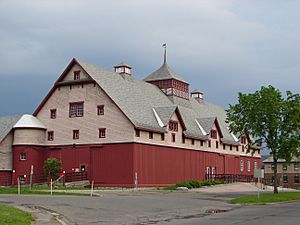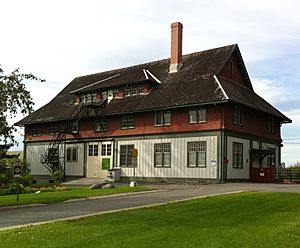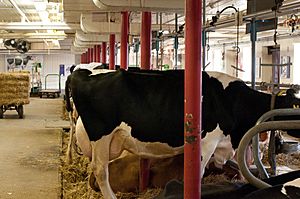Canada Agriculture and Food Museum facts for kids
| Musée de l'agriculture et de l'alimentation du Canada | |

Exterior of museum's main building, "Building 88"
|
|
| Established | 12 October 1983 |
|---|---|
| Location | 901 Prince of Wales Drive, Ottawa, Ontario, Canada |
| Type | Agricultural museum |
| Visitors | 202,000 (FY2018–19) |
| Ingenium | |
|
|
The Canada Agriculture and Food Museum (French: Musée de l'agriculture et de l'alimentation du Canada) is a special place in Ottawa, Ontario, Canada. It's a national museum that teaches us all about farming and food.
This museum is located on the Central Experimental Farm. It's not just a place with old displays; it's a "working farm"! This means you can see real farm animals and learn how a farm operates. The museum offers fun programs and shows about farming science. It also shares the amazing story of how farming grew in Canada over time. Besides the exhibits at the museum, they also create special shows that travel to other museums across Canada.
The museum's collection started way back in 1920 at the Central Experimental Farm. However, the official national agriculture museum opened much later, in October 1983. It was first called the Agriculture Museum. It began in just one building, a dairy barn. Over time, it grew to include several other buildings on the farm. The museum changed its name to the Canada Agriculture Museum in May 2000. Then, in May 2013, it got its current name: the Canada Agriculture and Food Museum.
Contents
History of the Museum
The items you see at the Canada Agriculture and Food Museum today began as a collection at the Central Experimental Farm in 1920. Later, the National Museums of Canada (NMC) took care of this collection. Some pieces were moved to other museums, like the Canadian Museum of History or the Canada Science and Technology Museum.
How the Museum Started
In 1978, people started talking about creating a proper farming museum. They looked at old buildings on the Central Experimental Farm to see if one would work. By 1980, the top floor of the dairy barn was chosen to hold the exhibits.
A special agreement was made between Agriculture and Agri-Food Canada and the NMC. Agriculture and Agri-Food Canada agreed to provide the building and fix it up. The NMC agreed to run the museum. The farming items already collected by the NMC became the main part of the new museum's collection.
Opening Day and Growth
The building was ready in August 1983. The NMC then set up the first two exhibits. One was called "Haying in Canada," showing farm tools from 1840 to 1960. The other was "A Barn of the Twenties," which made you feel like you were in a barn from the 1920s.
The museum officially opened on October 12, 1983, as the Agriculture Museum. Since then, the museum has grown a lot. It now uses seven buildings for visitors and staff, not just the dairy barn.
Changes in Management and Name
The NMC ran the museum until it closed in 1988. After that, a group called Ingenium took over. Ingenium is a special organization that looks after Canada's science and technology history.
The museum has changed its name twice in recent years. In May 2000, it became the Canada Agriculture Museum. Then, in May 2013, it was renamed the Canada Agriculture and Food Museum.
Museum Buildings and Grounds

The museum is located inside the Central Experimental Farm. This farm is a research center for Agriculture and Agri-Food Canada. Even though the museum uses many buildings on the farm, Agriculture and Agri-Food Canada still owns them.
The Main Dairy Barn
The main building of the museum is called the "Dairy Barn" or "Building 88." It's a three-story barn with a pointed roof and two side sections. The building is made from stone, wood shingles, and wood strips.
The original barn was built in 1887–88. Sadly, a fire destroyed it, so it was rebuilt in 1913. Because this building was so important for dairy farm research, it was named a Federal Heritage Building in 1987. Today, this building holds the museum's exhibits and is home to its dairy cows.
Other Important Buildings
The museum also uses other buildings, like the "Swine Showcase Building" or "Building 91." This building was built in 1911 and updated in the 1930s. It used to be where they tested pigs, but now it's part of the museum.
Other buildings are used for events. These include the "Meadowview Barn/Building 95" and the "Cereal Barn/Building 76." The Meadowview Barn was built in 1912 for dairy research. Now, the museum uses it for special events and summer camps. The Cereal Barn is also a popular spot for events.
What You Can Do at the Museum

The museum is run by Ingenium. This organization works to protect Canada's history in science and technology. Ingenium also manages two other national museums: the Canada Aviation and Space Museum and the Canada Science and Technology Museum.
Learning About Farming
The Canada Agriculture and Food Museum offers programs and exhibits. These teach visitors about the history of farming in Canada. They also show how science helps us with agriculture.
Since it's on the Central Experimental Farm, the museum is a "working farm." You can see about 150 farm animals there! This includes a herd of 50 dairy cows, plus horses, beef cattle, pigs, goats, chickens, and sheep. Besides learning about farming history, you can also see a collection of old tractors.
Special Programs and Exhibits
The museum also creates special exhibits that travel to smaller museums across Canada. They have an outdoor "energy park" where you can learn about clean energy sources.
Beyond the exhibits, the museum offers live demonstrations. You can also rent parts of the museum for special events.
See also
- Agriculture in Canada
- Manitoba Agricultural Museum
- Ontario Agricultural Museum
- Ornamental Gardens

